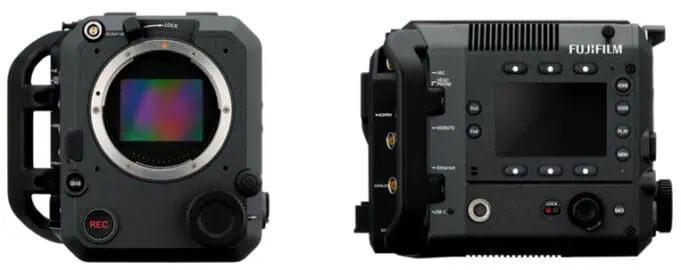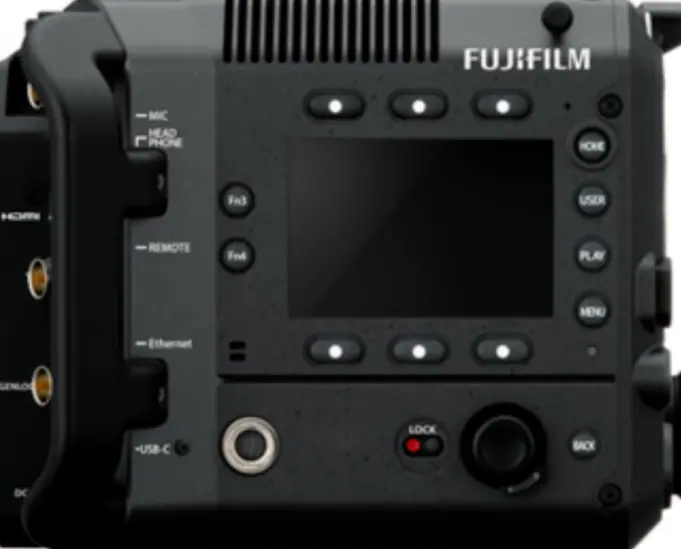We’re not seeing many new cameras in the cinema world — most these days it seems are aimed at content creators, YouTubers and social media climbers.
Today Fujifilm bucked that trend. In a short announcement on its site, the famed Japanese camera maker revealed it had plans to launch a brand new cinema camera in 2025.
Called the “FUJIFILM GFX ETERNA” (GFX ETERNA), the new camera will feature a large format sensor called — also in caps! — “GFX 102MP CMOS II HS” along with the CPU which they are calling “X-Processor 5”. Fujifilm points out that these are the same technologies used in its existing GFX100 II mirrorless camera.
The public can get a sneak peek at the new GFX Eterna this week at the InterBEE 2024 media event (November 13 – 15, 2024).
Fujifilm cited the growing demand in the film production industry for “high-quality videos” that can be produced “quickly and inexpensively” including feature films, short films, documentaries and web content.
Fujifilm GFX Eterna: Key Features

While no features have been released (aside from the aforementioned sensor and processor), Fujifilm did include two images that ran in the header of the press release. One shot is from the front, the other from the right hand side (non-operator).
Obviously we can tell right away the design is in the style of the popular box camera format. Meaning this will be a riggable small body that does not feature a built in monitor and shies away from conventional DSLR and mirrorless body styles that we’ve seen in the world of photography for decades. We’ve seen box cameras on models such as the RED Komodo/Komodo-X and, most recently, the new Blackmagic Pyxis.
Fujifilm GFX Eterna: Key Features (So Far)
While Fujifilm has yet to release detailed specs, here’s what has been revealed:
- Large format sensor: GFX 102MP CMOS II HS
- Processor: X-Processor 5, the same as in the GFX100 II mirrorless camera
- Box-style design: Compact and riggable, ideal for professional setups
- Video-centric build: Includes SDI ports, customizable soft keys, and a side control panel
On the front the large sensor dominates. It’s large! (and my guess: expensive). There’s a record button, a wheel on the opposite side, and maybe a smaller one (or button) right next to it. On top there’s a lens lock and some sort of small interface connector.
Because the photos are low resolution it’s hard to say exactly what we’re looking at, but we can guess further. On the side there’s a small screen, presumably for settings and navigating menus. It’s flanked by six soft keys. And then there’s a variety of other buttons spread across the side, likely for adjusting things like ISO, shutter, f-stop and various shooting modes.
Finally, slightly visible on the rear are two SDI ports.
What to think of the upcoming Fujifilm GFX Eterna?
First, this is exciting!
Since this is Fujifilm’s first purpose-built cinema camera not in a traditional mirrorless body, camera history will be made next year.
Sony competes in this space. As does Canon. And Nikon recently upped its cinema chops with the acquisition of RED Cinema (USA). So it only makes sense that an iconic brand like Fujifilm look to expand into this same space.
One interesting thing is the decision to opt for a medium format sensor. Traditional cinematography has been all about Super 35, and lately we’re seeing full frame become more common. But medium format? That’s a rarity on the cinema side. I suspect to move that many pixels (102 MP!) will require a substantial amount of processing power. That could negatively impact some features that many users crave such as high frame rates and fast rolling shutter.
Regardless, Fujifilm tends to be more about the art of the vocation, and not so much the balls-to-the-wall exotic sports car performance numbers.
Positioning in a Competitive Market
The GFX Eterna’s pricing hasn’t been disclosed, but it’s expected to land in the premium cinema segment. For context:
- RED Komodo-X: $6,995 (recently discounted from $9,999)
- Canon EOS C400: $7,999
- Sony FX6: $5,998
- Blackmagic Pyxis 6K: $2,995
Given the GFX100 II’s price of $7,499, the GFX Eterna will likely target a similar bracket, making it a contender for serious filmmakers with medium-format aspirations.
Given that the GFX100 I mirrorless camera retails for $7,499 (USD) here in the US, don’t expect this new GFX Eterna to sell for less. In fact the sweet spot for this type of performance seems to be in this neighborhood. The RED Komodo-X originally launched at $9,999 before being reduced to $6,995 post Nikon acquisition. The new Canon EOS C400 6K full-frame cinema camera is priced at $7,999. And the popular Sony FX6 comes in at $5,998. Meanwhile, Blackmagic, as it is wont to do, undercuts them all, with the Pyxis 6K selling for a segment busting $2,995.
Shooters invested in the Fujifilm system who also work on the video side, professionally or otherwise, will likely be happy to see this upcoming cinema body. Well, with one caveat: so long as that system is the medium format G mount.
The Internet Reacts
Of course no new camera release would be complete without immediate and swift internet reaction, including myriad complaints that seemingly prevent us all from completing are next project because a camera is missing ND filters. Here are some highlights that ChatGPT collated for the Fujifilm GFX Eterna (including some actual positive stuff!):
1. Excitement for Medium Format in Cinema: Many users are intrigued by the inclusion of a medium-format sensor, noting its rarity in the cinema world. This innovation has sparked discussions about how it could provide unique aesthetic qualities, such as shallower depth of field and broader dynamic range, making it a strong contender for high-end cinematography.
2. Concerns About Practicality: While medium format excites many, users have raised concerns about potential trade-offs. The large sensor and high resolution may challenge rolling shutter performance and high-frame-rate capabilities, which are critical for many cinema applications.
3. Design and Usability: The box-style design, reminiscent of cinema cameras like the RED Komodo-X and Blackmagic Pyxis, has been praised for its modularity and rigging options. However, some users speculate about its ergonomics and whether Fujifilm will provide robust native lens support for the GFX mount.
4. Price Expectations: Given the pricing of Fujifilm’s GFX100 II camera and competitive models like the RED Komodo-X and Blackmagic Pyxis, many are bracing for a high price point. However, there’s acknowledgment that this aligns with the camera’s professional focus.
5. Future Impact: Users see this as a bold move by Fujifilm into the cinema space, potentially shaking up the market. The camera’s success may hinge on its ability to balance innovative features with practical, real-world performance demanded by cinematographers.
For more detailed user reactions, you can check the original post on Newsshooter.
In any case it will be an exciting development, not just for Fujifilm, but for the entire industry. We’ve recent price drops (Komodo-X), as well as industry consolidation (Nikon acquiring RED). A new cinema camera from an iconic camera company further adds spice to things. More to come!


